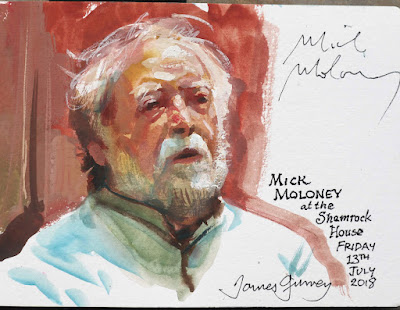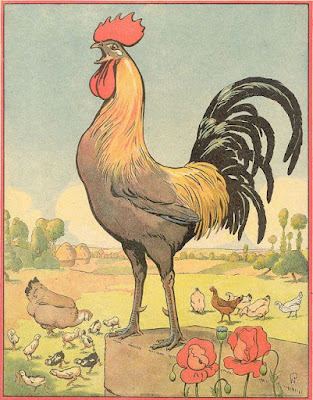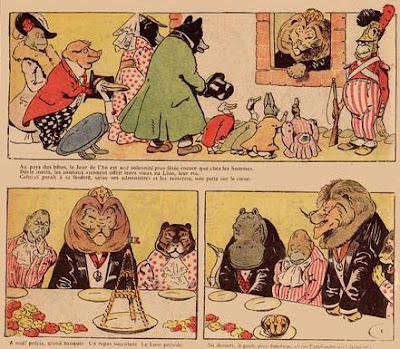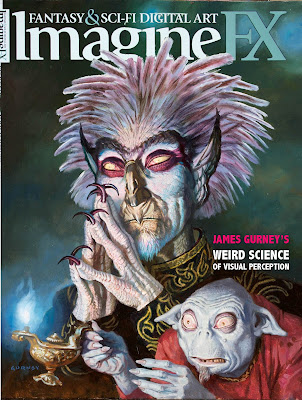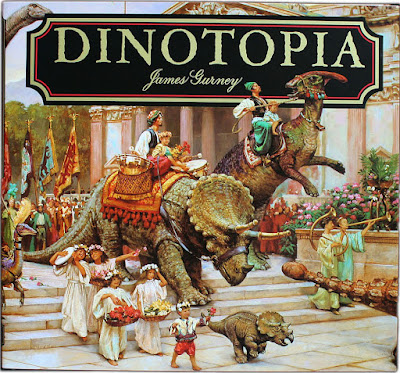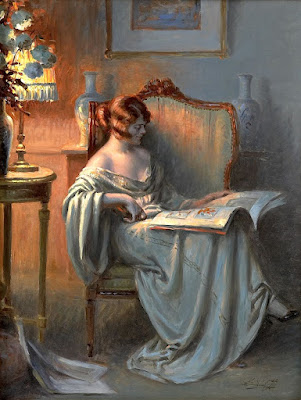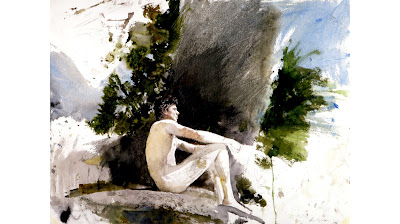Sunday, July 31, 2022
Saturday, July 30, 2022
Spontaneous vs. Controlled
Nita Engle (American, 1925-2019) was a watercolorist who combined wild spontaneity with a controlled focus.
In her book "How to Make a Watercolor Paint Itself," she says: "My method of working consists of two parts: a wild, spontaneous phase, in which I aim to create a field of texture that will give the illusion of, say, water, a daisy field, trees, or whatever; and a realism phase, in which I select small areas, usually in the foreground, and add careful detail so the viewer's eye will read the rest as reality."
"In the first phase I apply the water and paint and follow it wherever it leads with no censoring....After the paint is dry, the thinking phase begins."
Book: "How to Make a Watercolor Paint Itself" by Nita EngleFriday, July 29, 2022
Dinotopia Sand Sculptures
Thursday, July 28, 2022
Mick Moloney, 1944-2022
He loved to tell the stories and sing the songs of Irish immigrants in America through his recordings, teachings, and publications.
Tuesday, July 26, 2022
Raymond de la Nézière, Animal Artist
Monday, July 25, 2022
Egyptian Painter's Palette
Sunday, July 24, 2022
Fire and Ice Background
A background for the Bakshi / Frazetta film "Fire and Ice" (1983), cel vinyl and acrylic paint.
Saturday, July 23, 2022
Weird Science of Visual Perception
This was a cover feature I proposed for ImagineFX Magazine . They never used it, but I still believe it would be an awesome subject for artists.
Birdman, oil. I used mainly four colors: viridian, permanent alizarin, yellow ochre, and cerulean.
Read my previous posts on Visual Perception
Friday, July 22, 2022
The Role of Prediction in Perception
"The mind is a prediction engine, and nowhere is this more true than in visual perception."

In his book "The Mind: Consciousness, Prediction, and the Brain," by E. Bruce Goldstein details current research about how the process of visual perception.
What happens when we see is that the brain creates a top-down model of the world and continually checks it against the input coming from our senses.
"The mind encompasses everything we experience," he says, "and these experiences are created by the brain--often without our awareness. Experience is private; we can't know the minds of others. But we also don't know what is happening in our own minds."Thursday, July 21, 2022
Worlds Within Worlds
"The grandest and simplest things contain worlds within worlds. Seeing them is a matter of the right point of view, and your painter's eye is the special portal to such sights."
Wednesday, July 20, 2022
Staying Focused During a Plein-Air Session
Here's a new YouTube video that I call "This Botanical Study Nearly Broke My Brain."
Tuesday, July 19, 2022
Frederic Church's Area-by-Area Process

Monday, July 18, 2022
Police Dock from Sleightsburgh
Sunday, July 17, 2022
Kelsey's and Anoosha's Art-Book Videos
Kelsey Rodriguez's YouTube channel has made her a hero for self-taught artists, so I was pleased that she included my book Color and Light among her recommendations in her video on YouTube
Friday, July 15, 2022
Light from a Low Sun
Thursday, July 14, 2022
Painting Water: Start Wet, End Dry
Wednesday, July 13, 2022
Dinotopia Audio Drama
Strap on your headphones and pack your bags for a trip to Dinotopia via the full-cast audio drama by ZBS Productions. You can listen for free (with a few ads) on Dramafy.
Tuesday, July 12, 2022
Laloue's Dots and Lines
Monday, July 11, 2022
Using White Pastel over Gouache
White Nupastel or white Carb-O-Thello can suggest the effect of window light spilling over the edges of forms silhouetted against it.
Sunday, July 10, 2022
Lamplight Fantasies of Delphin Enjolras
During his lifetime he witnessed the invention and adoption of electric light, which must have seemed magical, especially when the warm glow of the light was contrasted with the cool light of the sky.
Saturday, July 9, 2022
Wyeth Drawings on Display
N.C. Wyeth, seated nude, charcoal, 1900.
The art produced by the Wyeth lineage—N.C., Andrew, Carolyn, and Jamie—grows out of a tradition of academic drawing and close observation.
In the case of Andrew, Carolyn, and Jamie, it wasn't an atelier or an art school setting where they learned these skills, but something passed down privately through the family.
Andrew Wyeth, charcoal portrait of Martin Leonard, 1936
The Fenimore Art Museum is currently displaying these mostly unpublished and unseen drawings. They're divided into several categories; academic renderings, figure studies, anatomy drawings, observations of the model, and animal sketches.
N.C. Wyeth, Oisin in the Land of Youth (composition drawing), 1940, graphite
Victoria Wyeth, Andrew's granddaughter, curated the show with the help of her uncle Jamie.
They offer the benefit of an insider's perceptions. They recall, for example, that Carolyn would walk around in studio wearing her father's knickers, which were eccentric even in N.C.'s day.
Jamie Wyeth, pig drawing, 1969
There are a lot of kinds of observational drawings on view, so the art student or practicing artist will enjoy the behind-the-scenes glimpses.
However, I wish there were more imaginative drawings, thumbnails, process pieces and a few finished paintings that would have shown the complete evolution of an idea from first concept to the end result.
Andrew Wyeth, Undercover Study, 1970, watercolor (included)
--
Drawn from Life: Three Generations of Wyeth Figure Studies is at the Fenimore Art Museum in Cooperstown, NY through September 5
Friday, July 8, 2022
Day and Night in Venice
Walter Launt Palmer (American, 1854-1932) painted a similar view of Santa Maria della Salute in the daylight and moonlight.
While visiting Venice in the 1890s, he painted this view on a sunny day, with warm white and orange sails reflecting in the still water, and the alabaster domes gleaming behind.

Both paintings are included in an exhibit called "Unmasking Venice: American Artists and the City of Water," now on view at the Fenimore Art Museum in Cooperstown, NY through September 5.
Wednesday, July 6, 2022
Macchiaioli at the Caffè Michelangelo
"In the1850s Fattori began frequenting the Caffè Michelangiolo on via Larga, a popular gathering place for Florentine artists who carried on lively discussions of politics and new trends in art. Several of these artists would discover the work of the painters of the Barbizon school while visiting Paris for the Exposition of 1855, and would bring back to Italy an enthusiasm for the then-novel practice of painting outdoors, directly from nature."
"In 1859 Fattori met Roman landscape painter Giovanni Costa, whose example influenced him to join his colleagues and take up painting realistic landscapes and scenes of contemporary life en plein air. This marked a turning point in Fattori's development: he became a member of the Macchiaioli, a group of Tuscan painters whose methods and aims are somewhat similar to those of the Impressionists, of which they are considered forerunners."
Tuesday, July 5, 2022
Monday, July 4, 2022
The Soup Machine

I came back on a Sunday when the site was deserted. I picked a low angle and silhouetted it against the sky, with the lines of perspective leading back behind the blackened engine mounted on the tank.
To convey the feeling of the smoggy day, I lightened the values of the more distant area. To create the sky gradation, I used a cotton rag that had been charged with black marker dye and gently rubbed across the surface.
Sunday, July 3, 2022
Will and Cirrus Explore the Ruins
During a mission to protect a convoy traveling through the Rainy Basin, Will Denison and his skybax Cirrus discover ancient ruins.
The ruins contain evidence of the ancient civilization of Poseidos and the weird deities they seemed to worship.Saturday, July 2, 2022
How I Label My Sketchbooks
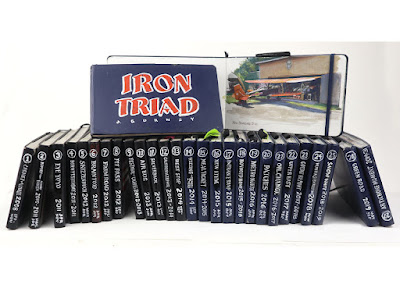
Friday, July 1, 2022
The Stamp Art Was Almost Lost in the Mail
Funny story about these stamps: the original art was almost LOST IN THE MAIL.






